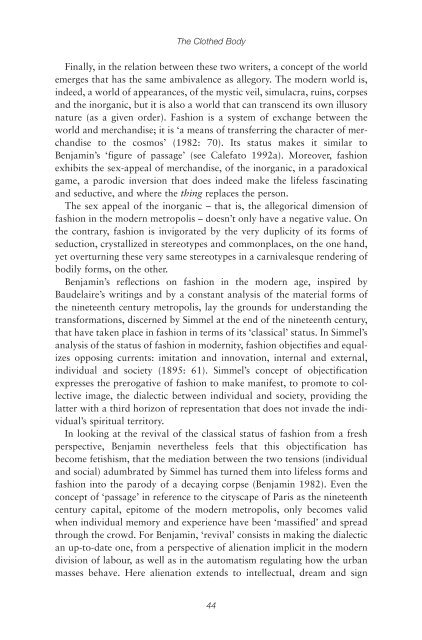Create successful ePaper yourself
Turn your PDF publications into a flip-book with our unique Google optimized e-Paper software.
<strong>The</strong> <strong>Clothed</strong> <strong>Body</strong><br />
Finally, in the relation between these two writers, a concept of the world<br />
emerges that has the same ambivalence as allegory. <strong>The</strong> modern world is,<br />
indeed, a world of appearances, of the mystic veil, simulacra, ruins, corpses<br />
and the inorganic, but it is also a world that can transcend its own illusory<br />
nature (as a given order). Fashion is a system of exchange between the<br />
world and merchandise; it is ‘a means of transferring the character of merchandise<br />
to the cosmos’ (1982: 70). Its status makes it similar to<br />
Benjamin’s ‘figure of passage’ (see Calefato 1992a). Moreover, fashion<br />
exhibits the sex-appeal of merchandise, of the inorganic, in a paradoxical<br />
game, a parodic inversion that does indeed make the lifeless fascinating<br />
and seductive, and where the thing replaces the person.<br />
<strong>The</strong> sex appeal of the inorganic – that is, the allegorical dimension of<br />
fashion in the modern metropolis – doesn’t only have a negative value. On<br />
the contrary, fashion is invigorated by the very duplicity of its forms of<br />
seduction, crystallized in stereotypes and commonplaces, on the one hand,<br />
yet overturning these very same stereotypes in a carnivalesque rendering of<br />
bodily forms, on the other.<br />
Benjamin’s reflections on fashion in the modern age, inspired by<br />
Baudelaire’s writings and by a constant analysis of the material forms of<br />
the nineteenth century metropolis, lay the grounds for understanding the<br />
transformations, discerned by Simmel at the end of the nineteenth century,<br />
that have taken place in fashion in terms of its ‘classical’ status. In Simmel’s<br />
analysis of the status of fashion in modernity, fashion objectifies and equalizes<br />
opposing currents: imitation and innovation, internal and external,<br />
individual and society (1895: 61). Simmel’s concept of objectification<br />
expresses the prerogative of fashion to make manifest, to promote to collective<br />
image, the dialectic between individual and society, providing the<br />
latter with a third horizon of representation that does not invade the individual’s<br />
spiritual territory.<br />
In looking at the revival of the classical status of fashion from a fresh<br />
perspective, Benjamin nevertheless feels that this objectification has<br />
become fetishism, that the mediation between the two tensions (individual<br />
and social) adumbrated by Simmel has turned them into lifeless forms and<br />
fashion into the parody of a decaying corpse (Benjamin 1982). Even the<br />
concept of ‘passage’ in reference to the cityscape of Paris as the nineteenth<br />
century capital, epitome of the modern metropolis, only becomes valid<br />
when individual memory and experience have been ‘massified’ and spread<br />
through the crowd. For Benjamin, ‘revival’ consists in making the dialectic<br />
an up-to-date one, from a perspective of alienation implicit in the modern<br />
division of labour, as well as in the automatism regulating how the urban<br />
masses behave. Here alienation extends to intellectual, dream and sign<br />
44

















